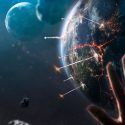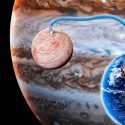You start your day hearing wild news. Jupiter has just swallowed Saturn. And it doesn’t stop there. Jupiter is on its way to swallow every planet in the Solar System. How big would Jupiter get? What would you see from Earth? Would Jupiter get rings like Saturn?
Jupiter has swallowed a planet before. Around 4.5 billion years ago, a protoplanet slammed into the young Jupiter. The protoplanet was 10 times the Earth’s mass, made of rocky and icy material.
Jupiter’s core broke apart, and denser material mixed with hydrogen and helium. A few billion years later, the heavy material settled back into the dense core that we see today. Swallowing a single planet is one thing, but could Jupiter eat up all seven?
In this scenario, you’re going to see the planets get swallowed from largest to smallest. Although we’re saving Earth for last.
But before we start plunging our Solar System into chaos, let me tell you about chaos in a non-hypothetical world, the internet. I search it a lot. And I know that companies are collecting and storing my personal data. But it seems impossible to figure out where my data is and how I can erase it.
Jupiter’s first victim would be Saturn. From Earth, you could see these gas giants as two bright stars. And if you were to look up at the night sky as Jupiter swallows Saturn, all you’d see is Jupiter getting super bright. But if you were closer to the action, you’d see complete chaos.
Jupiter is only three times heavier than Saturn, so it would be swallowing a planet that’s almost its size.First, their moons would collide, creating massive amounts of debris. Some moon remnants would rain down onto Jupiter. And some of the debris would float in space.
As Jupiter was crashing into Saturn, Jupiter’s surface temperature would become hotter than the Sun’s outer layer. Whatever remained of Saturn would mix in with Jupiter’s atmosphere. They would become one. Swallowing Saturn would increase Jupiter’s mass and gravity by 30%. Jupiter would also sport prominent new rings from the shattered moons.
Next, it would envelop the two ice giants, Uranus and Neptune. The 27 moons of Uranus would collide with the rings of Jupiter, adding to the floating debris. Uranus has an icy core made of water, methane and ammonia. But Neptune’s inner core is rocky. Regardless, both cores would melt as the planets crashed into Jupiter.
Now Jupiter would be almost 40% heavier. And it would head toward its first rocky planetary snacks. The rocky planets, Venus and Mars, wouldn’t even make it to Jupiter’s core. They’d burn up in Jupiter’s atmosphere as if they were mere asteroids. Then we’d see our last planetary neighbor disappear inside this bulked up Jupiter. Mercury is even smaller than Jupiter’s largest moon, Ganymede. So it would get ripped apart by Jupiter’s rings, adding to the speedy debris.
Now, only Earth and Jupiter would be left. And Earth would be in big trouble. But how would Jupiter go about swallowing our planet?
Even in its normal state, without swallowing six planets, Jupiter’s gravitational force affects Earth.
Every 405,000 years, the pull of Jupiter and Venus makes Earth’s orbit wobble. It causes hotter summers, colder winters and more rainfall in the tropics. And now, Jupiter’s gravitational pull would be over 40% stronger.
But Jupiter’s pull would still be no match for the Sun’s gravitational force. So Jupiter would have to come for Earth just like it swallowed all the other planets in our Solar System. Jupiter doesn’t have a hard surface like the rocky planets. You could say Jupiter is a big, dense ball of gas. Its surface is defined as the point where its atmospheric pressure is equal to Earth’s.
So could the Earth simply pass through?
Sorry, but no. Just like the rest of the planets, Earth, and all life on it, would be toast.
First, we’d be bombarded by asteroids while passing through Jupiter’s rings. I doubt anyone would survive this. But if they did, they would see the Earth igniting as it enters Jupiter’s atmosphere. Jupiter is so massive that even if it were to swallow its seven planetary neighbors, it wouldn’t even double in size.
Now what would happen if Jupiter continued to grow? Well, even if Jupiter increased its mass by 400% (four times), it would stay about the same size. But the extra mass would make Jupiter so dense that it would start pulling in on itself. It would get smaller instead of larger. And if Jupiter were to increase its mass by 70,000% (70 times), it could trigger a fusion reaction and light up like a star.
Can you imagine what it would be like to have not one but two stars in the Solar System?
Sources
- “All You Need To Know: 2020’S Great Conjunction Of Jupiter And Saturn | Astronomy Essentials | Earthsky“. 2020. Earthsky | Updates On Your Cosmos And World.
- “The Planets In Our Solar System In Order Of Size – Universe Today“. 2014. Universe Today.
- “Jupiter Fact Sheet“. 2021. Nssdc.Gsfc.Nasa.Gov.
- “Planet 10 Times Earth’s Mass May Have Smacked Jupiter Long Ago“.Dunham, Will. 2021. U.S.
- “Gravity“. 2021. Xaktly.Com.



























